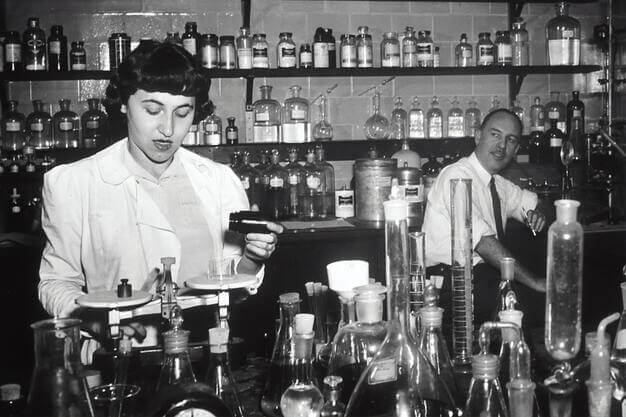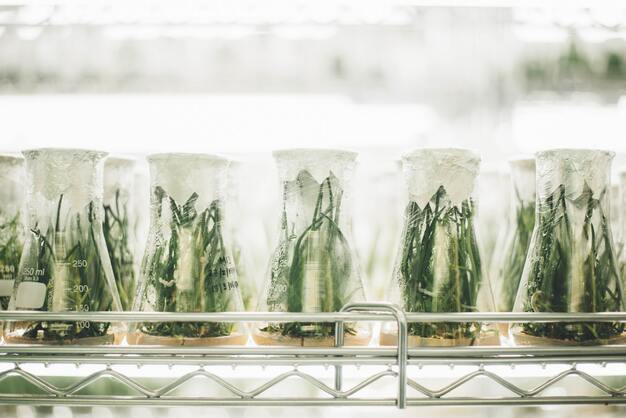Elena Canorea
Communications Lead
Desde Plain Concepts queremos presentaros: «The Trilogy: A webinar series for experts in biotech». Se trata de una serie de seminarios web para todos aquellos interesados en biotecnología y genómica.
Dividido en 3 partes, la primera con un enfoque empresarial y de innovación, la segunda con un enfoque de inmersión técnica profunda personalizado y la tercera dependerá de ti poder agendar una reunión con nosotros para traducir los conocimientos aprendidos y aplicarlos en tu empresa. Esta trilogía abordará temas como el futuro de AgriTech, la sostenibilidad, la accesibilidad, su crecimiento económico y su estrecha relación con la Industria 4.0, así como el uso de la tecnología para aumentar la innovación, acelerar los logros en I + D y mejorar la producción. En la parte final, tendrás la oportunidad de solicitar una sesión personalizada, en la que podrás aplicar tus aprendizajes y observar de cerca tu propia organización.
¡Vuelve a ver el evento sobre Biotech del año!
La biotecnología, muchas veces abreviada como biotech, no es una disciplina nueva, pero sus aplicaciones y avances en los últimos años son cada vez más sorprendentes y cruciales en nuestro día a día.
Actualmente, la biotecnología nos ayuda a combatir enfermedades, el hambre, reduce nuestra huella ecológica, ahorra energía, le da a la producción un carácter más seguro, limpio y eficiente… Esto también se refleja en los valores de Wall Street, que la sitúan como uno de los sectores más rentables del índice compuesto NASDAQ en 2019.
En los últimos meses, la biotecnología ha tomado la voz cantante en la industria farmacéutica, pues las vacunas son, probablemente, el tema más comentado en todo el mundo, y la biotecnología es el pilar principal.
En Plain Concepts somos socios tecnológicos de Biotech y ayudamos a empresas del sector a mejorar sus procesos en todo lo que necesiten para convertirse en compañías biotecnológicas de alto nivel.
La biotecnología se puede definir como el uso de sistemas biológicos que se encuentran en los organismos o el uso de los propios organismos vivos para realizar avances tecnológicos y adaptar esas tecnologías a diversos campos.
El biotech utiliza células vivas para desarrollar o manipular productos con fines específicos, como alimentos modificados genéticamente. Está muy ligada a la ingeniería genética y surge como un campo propio a principios del siglo XX, en la industria alimentaria, a la que posteriormente se suman otros sectores como la medicina, la agricultura y el medio ambiente.
Esta disciplina es particularmente crucial cuando se trata del desarrollo de herramientas químicas y minúsculas, ya que muchas de las herramientas que utiliza la biotecnología existen a nivel celular. Dependiendo de la tecnología, las herramientas y las aplicaciones implicadas, la biotecnología puede superponerse con la biología molecular, la biónica, la bioingeniería, la ingeniería genética y la nanotecnología.
Al aprovechar los procesos celulares y biomoleculares, los científicos pueden hacer avances y adaptaciones en varios campos, cuyos resultados han dado lugar al tratamiento de enfermedades, la reducción del impacto ambiental y un mejor uso de los recursos naturales, entre otros muchos.
Si nos basamos en la concepción más básica de la biotecnología, nos tendríamos que remontar a cientos de años, concretamente al momento en el que los seres humanos comenzaron a hacer pan o cerveza a través del proceso de fermentación.
Sin embargo, nos centraremos en el campo de la biotecnología moderna, que comenzó a desarrollarse rápidamente a partir del siglo XIX, con el descubrimiento de microorganismos, el estudio de Gregor Mendel de la genética, y el trabajo innovador sobre la fermentación y los procesos microbianos por gigantes en el campo como Pasteur y Lister. En 1919, el ingeniero agrónomo húngaro Karl Ereky vio todo el potencial que podría usarse para convertir las materias primas en productos útiles, y acuñó el término de “biotecnología”. Años después, Alexander Fleming compartiría uno de los grandes acontecimientos del siglo XX: el descubrimiento de la penicilina.
A partir de los años 50, se produjo el gran despegue de este campo, propiciado por por una mejor comprensión en el período de la posguerra de la función celular y la biología molecular. Desde entonces, los avances han ido dando saltos de gigante, y lo vemos en ejemplos como el descubrimiento de la estructura 3D del ADN (años 50), el desarrollo de vacunas para el sarampión, paperas y rubeola (años 60), avances masivos en la investigación del ADN (años 70), avance en medicamentos y vacunas para tratar el cáncer o la hepatitis B (años 80) o la finalización de la secuencia de genoma humanos para tratar enfermedades de origen genético como el cáncer, las enfermedades cardíacas y el Alzheimer (años 90).
Hoy en día, la industria ha generado gigantes en la industria médica, así como miles de empresas más pequeñas que se dedican al desarrollo de medicamentos o se han involucrado en áreas como los biocombustibles, la biorremediación y los productos alimenticios.

Dependiendo de sus usos o aplicaciones, la biotecnología se puede dividir en subdisciplinas separadas por colores.
También conocida como biología computacional, es la encargada de obtener, almacenar, analizar y separar información biológica, especialmente la relacionada con el ADN y las secuencias de aminoácidos. Aborda problemas biológicos utilizando técnicas computacionales y hace posible una organización mucho más rápida.
Es la encargada de crear nuevos medicamentos y productos veterinarios. Según la Organización de Innovación Biotecnológica (BIO), es la responsable del desarrollo de más de 250 vacunas y medicamentos como antibióticos, técnicas de diagnóstico molecular, terapias regenerativas y la producción de órganos artificiales.
Se centra en la rama industrial para diseñar y mejorar los procesos y productos de una forma más eficiente desde el punto de vista energético, además de desarrollar biocombustibles menos contaminantes y que consumen pocos recursos. La misión es crear tecnologías que ayuden en la evolución de una industria más eficiente y sostenible que pueda superar a la tradicional.
Está ligado a las aplicaciones ambientales para la conservación de la biodiversidad, así como la restauración de ecosistemas naturales contaminados, usando microorganismos y plantas para eliminar el mayor número de sustancias como metales pesados e hidrocarburos. Es decir, usando procesos de biorremediación.
Se encarga de la producción de alimentos, ligado a la elaboración, por ejemplo, de vino, cerveza o queso gracias a la fermentación. Pero no es la única aplicación, pues también investiga cómo reducir las grasas saturadas en los productos y conseguir una alimentación más sana.
Se centra en la rama de la agricultura y procesos agrícolas como la producción de cultivos resistentes a plagas, animales resistentes a enfermedades, biopesticidas y biofertilizantes cuya misión es nutrir cultivos contra microorganismos y eventos climáticos como sequías y heladas. Todo ello con un desarrollo respetuoso con el medio ambiente.
Como su nombre indica, se basa en el uso de recursos marinos y acuáticos para crear productos y aplicaciones de sectores acuícolas, cosméticos y sanitarios. Un ejemplo es el control de la proliferación de organismos nocivos transmitidos por el agua, pero también se utiliza para obtener biocombustibles a partir de determinadas microalgas.
Es, probablemente, la menos conocida, pues se ocupa de cuestiones legales, éticas y filosóficas, así como el cumplimiento de las mismas dentro del campo de la biotecnología.
Es la más peligrosa, pues está asociada a las armas biológicas o el bioterrorismo. Está relacionada con las guerras biológicas utilizando microorganismos y toxinas para causar enfermedades y la muerte en seres vivos, ya sean humanos, animales o cultivos.

Como hemos dicho más arriba, las aplicaciones de la biotecnología son infinitas y tendrán aún más presencia. En los últimos meses ha sido crucial para descifrar el genoma del virus de la COVID-19, y a entender cómo funciona el mecanismo de defensa de nuestro organismo frente a agentes infecciosos.
Por tanto, jugará un papel crucial de cara a curar y prevenir futuras patologías, pero no son las únicas aplicaciones. Estos son algunos de los campos en los que más presencia y trascendencia tiene:
La biotecnología médica es el uso de células vivas y otros materiales celulares para mejorar la salud de los seres humanos. Principalmente, se utiliza para encontrar curas, así como para eliminar y prevenir enfermedades. Sirve para comprender los patógenos y la biología celular humana, así como el estudio de bacterias, células vegetales y animales, con el objetivo de mantener la salud humana.
Implica, en gran parte, el estudio del ADN para saber cómo manipular la composición genética de las células para aumentar la producción de características beneficiosas que los humanos podrían encontrar útiles, como nuevos fármacos y tratamientos. Los ejemplos más comunes son:
Al aplicar las técnicas de la biología molecular moderna, se mejora la eficiencia y reduce los impactos ambientales multifacéticos de los procesos industriales, incluidos la fabricación de productos químicos y los textiles. Incluye la práctica de utilizar células de microorganismos o componentes de células, como enzimas, para generar productos en sectores que son industrialmente útiles, como alimentos y piensos, químicos, detergentes, papel, textiles…
Pronto podremos tener hormigón autocurativo, plantas que cambian de color cuando detectan un explosivo, ropa y calzado confeccionado con telaraña sintética, etc.
Los avances tecnológicos también han llegado al modelo de agricultura tradicional, donde se está optando por cambiar a cultivos modificados genéticamente como una alternativa. Esto permitiría obtener el máximo rendimiento de los campos y minimizar el uso de fertilizantes y productos químicos para que no haya efectos nocivos sobre el medio ambiente.
Se consiguen cultivos más tolerantes a los estreses abióticos (frío, sequía, sal, calor), menor dependencia de pesticidas químicos, reducción de pérdidas postcosecha, mejora en el valor nutricional de los productos… Algunos ejemplos son los siguientes:
Con todos los problemas de desnutrición o problemas de alimentación que existen en el mundo, la biotecnología ayuda a la infusión de nutrientes en los alimentos en las situaciones más extremas. Un ejemplo de esta aplicación es la producción de arroz dorado, donde el arroz se infunde con betacaroteno y se puede sintetizar más rápidamente.
Los ejemplos más comunes:
La biotecnología ambiental es la tecnología utilizada en el tratamiento de desechos y la prevención de la contaminación. Puede limpiar muchos desechos de manera más eficiente en comparación con los métodos convencionales y reducir significativamente nuestra dependencia de los métodos de eliminación en la tierra. Por ello, se introducen nutrientes para estimular la actividad de las bacterias que ya existen en el suelo de un vertedero o para agregar nuevas bacterias al suelo. Las bacterias ayudan a digerir los desechos directamente en el sitio, convirtiéndolos en subproductos inofensivos.
Mediante procesos de biorremediación, muy útiles para la recuperación ecológica, se utilizan las propiedades catabólicas de microorganismos, hongos, plantas y enzimas para restaurar ecosistemas contaminados. Algunos ejemplos son:
Elena Canorea
Communications Lead
